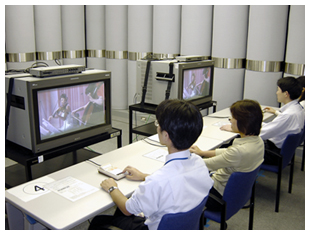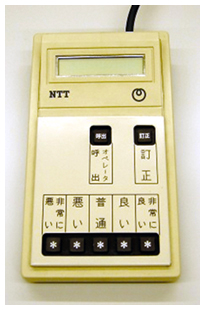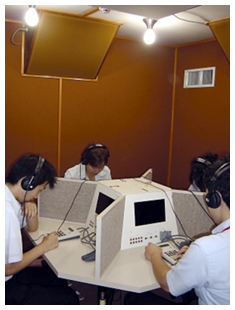 |
|
|
|
|
|
Spotlight on NTT Laboratories Vol. 6, No. 2, pp. 1–5, Feb. 2008. https://doi.org/10.53829/ntr200802lab  Providing Cross-Laboratory Oversight and Promoting Strategic R&D toward CommercializationLocated in the Musashino R&D Center, NTT Service Integration Laboratories has the role of proposing cross-laboratory products developed by NTT Laboratories to NTT business companies. It is known for its many contact points with NTT's business companies compared with the other research laboratories. We talked with General Manager Kou Miyake to find out more about this fascinating role of NTT Service Integration Laboratories. Position and role of NTT Service Integration Laboratories—Dr. Miyake, please tell us about the position and role of the Service Integration Laboratories within NTT Laboratories. NTT Service Integration Laboratories is part of the Information Sharing Laboratory Group. Our mission is to promote strategic planning of cross-laboratory research and development within NTT Laboratories. Strategic planning of R&D gives close consideration to what kind of technology should be developed and promoted over the medium and long terms while observing real-world conditions and the state of NTT business companies, and it attempts to establish specific directions. For example, we are highly involved in developing technologies for the network as a whole, including network architecture and quality and traffic control technologies, and in applying the results of NTT Laboratories to business. —The role of the Service Integration Laboratories appears to be quite different from that of the other laboratories. That's right. The Service Integration Laboratories now consists of six major projects: NGN System Architecture Project, Service Innovation Project, Communication Traffic and Service Quality Project, Service Deployment Strategy Project for Business Promotion, System Development Support Project, and Smart Card Service Promotion Project. The first three deal with the question of how to go about constructing NTT's infrastructure network centered on the Next Generation Network over the coming years. The researchers involved in this work therefore constitute a group that studies overall strategic ideas as opposed to crafting network systems (monozukuri). Each of the last three projects has a particular mission. First, the Business Promotion Project aims to introduce products from NTT Laboratories into the business companies as smoothly as possible. In addition to the actual work of product introduction, this project creates and develops new R&D schemes to sow the seeds of new technology in collaboration with academia. Next, the System Development Support Project manages software quality control. There is always a gap between the quality of a prototype product and the quality required of that product in a commercial system, and it is the job of this project to perform cross-project management to eliminate that gap. Finally, the role of the Smart Card Service Promotion Project is to maintain and functionally enhance smart cards incorporated into resident cards based on Japan's Basic Resident Register and to develop new smart cards. At first glance, it may seem that each of these projects operates on its own, but in reality, each has a cross-laboratory mission that requires it to interact with various research laboratories. Accordingly, while the Service Integration Laboratories belongs to the Information Sharing Laboratory Group from an organizational viewpoint, it collaborates extensively with the Cyber Communications Laboratory Group and the Science and Core Technology Laboratory Group as needed to establish R&D strategy. In this sense, I would like you to understand that the Service Integration Laboratories provides R&D support to each of these laboratory groups. Promoting necessary reforms for commercializing products—How do you sell the products of NTT Laboratories to NTT business companies so as to commercialize research results? Actually, for products of service-related laboratories that the business companies promote to the corporate world, the sales technique for those products is now being turned on its head. The traditional technique was to approach the business companies with products that were more or less completed at NTT Laboratories in the manner of “Would you like to use these?” This approach, however, puts products first, which is no different, I think, from the way in which vendors push their wares. In contrast, considering that NTT Laboratories is a research organization expressly for the NTT Group, shouldn't it be important to hold discussions and open up communication channels as far in advance as possible to determine what kinds of businesses and services the business companies in the same group would like to develop in future? We must therefore have a clear understanding of customer desires when we create products. By doing so, we can eliminate the gap between products and real needs. To this end, we must communicate more closely, be aware of and share information about the future needs of business companies, and quickly feed comments and opinions from those companies back to NTT Laboratories. In addition, I feel that the techniques that are now being used to manage development at NTT Laboratories need to be reviewed and revised. There is a big gap between making products and sending them out into the world for commercialization. In the real world, a great idea does not guarantee the success of a product. I therefore think that we should develop new techniques for promoting commercial products and solidify those techniques on the management level. Obstacles to commercialization that must be overcome—What is needed to eliminate the gap between a prototype and the commercial product? Well, at the prototype stage, for a simple application, a researcher comes up with an idea and then builds a model called a mockup to visualize the product in reality. However, when it comes time to think about commercializing the product, various environmental requirements come into play considering that the product will be used by thousands of people. Design must be performed carefully while asking key questions like how reliable the operating system, middleware, and other software must be and on what scale and at what performance level the product should be able to run. A firm foundation must be laid down for the product in this way. Technology of this sort is on a fundamentally different level from that of a simple application developed by one or two people. In actual development work, it is impossible for NTT Laboratories to go it alone—some form of collaboration with development companies outside our laboratories is required. Using a staff of dozens of people, we must design the system, manage the development project, and establish a documentation process for sharing information. And all kinds of problems that arise during the course of development must be solved in a collaborative manner. Also, in the case of information systems, it was typical in the past for everything from hardware to the operating system to be jointly developed by NTT and manufacturers, and for unified systems from applications to platforms to be used. Nowadays, however, the development skills that are valued are those that can construct large-scale systems by cleverly combining and using commercially available middleware, database systems, and various types of packaged software. Unfortunately, it cannot be denied that there is little awareness of the great difference between this new environment and past conditions; nor is there much of an effort to deal with it when it comes time to create a commercial product. Setting up measures to cultivate these skills is therefore a matter of great urgency. What one can do and must do are two different things—What is difficult for you yourself in your role as a promoter of renewed awareness within the Service Integration Laboratories? To begin with, our research staff should be continuously aware of problems, and they themselves should define issues and come up with ways of resolving them. I would like this to be understood by those members of staff that will be a driving force behind the Service Integration Laboratories in the future. What worries me is how best to go about changing staff awareness in this regard. When given a problem, NTT researchers make every effort to solve it, but they are somehow not very good at discovering the problems on their own. From my viewpoint, there is also an aspect of cheating in this. What I mean by this is that researchers decide beforehand what they themselves can do. What must, in essence, be done and what one thinks one is capable of doing are not the same. It is far more comfortable to set the limits of your capabilities yourself. That, however, is looking at things from the researcher's point of view; there is a big gap between that and what is useful to business. Before becoming the general manager of the Service Integration Laboratories, I served as president of NTT DATA INTELLILINK, a subsidiary of NTT DATA. My experiences there taught me how important it is for a business company to generate sales and increase profits in order to survive. It came down to evaluating figures from beginning to end. Accordingly, when thinking about what must be done to produce results, I know that no results will be achieved by considering only what one thinks one can do. Medium- and long-term outlooks—Dr. Miyake, what issues have to be addressed at the Service Integration Laboratories from here on? For one thing, we must somehow deal with a change in the structure of the network architecture while inheriting the know-how that NTT has built up to date. To this end, it is essential that we train people so that they can inherit NTT technologies and systems. In addition, we must deal with the issue of what kinds of services should be developed, and we must construct a mechanism that can provide whatever services we decide upon in harmony with the technical and social environment. Here, it is important, of course, to carefully ascertain the validity of technology itself, and at the same time, to determine what kinds of products are currently being offered while observing trends in industry and current services and markets and to manage closely the timing for sowing crucial technology seeds. Notable places in the Service Integration LaboratoriesMultimedia quality assessment boothUnderstanding users' demands for quality is essential in designing and managing good multimedia communication services. The multimedia quality assessment booth (Photo 1) is a room especially designed for evaluating the quality of videophone, IPTV (Internet protocol television), and other advanced services that will be offered on the Next Generation Network. The room is equipped with rating devices like the one shown in Photo 2 for service-quality assessment experiments with many subjects (customers) that NTT recruits. The environment inside the room can also be controlled to ensure accurate evaluation results. For example, the vertical cylinders that can be seen along the wall in Photo 1 are covered in sound-absorbing material on one side and sound-reflecting material on the other side. Thus, the room's acoustics can be changed as desired simply be rotating these cylinders, and a variety of acoustic environments can be reproduced.
Speech quality assessment boothThe speech quality assessment booth (Photo 3) is a room designed for evaluating the speech quality of telephone calls made using handsets or headsets. This booth has historically been used to establish quality criteria for telephone services in Japan. More recently, it has come to be used to evaluate the quality of IP-phone services and has been contributing to the production of high-quality comfortable telephone services.
Service Integration Laboratories:Promoting interaction with the outsideThe Service Integration Laboratories is active in various ways to connect the products of NTT Laboratories with commercial applications. One way is to hold a lecture once a month in a hall in the Mus y for the benefit of all laboratory staff. The first two lectures were given by General Manager Kou Miyake, who talked about management, reading balance sheets, and other issues based on his experiences as president of an NTT business company. Thinking, however, that “lectures given only by me are not going to be very interesting,” he considered the benefits of inviting people currently on assignment in NTT Group companies or outside people on assignment in the Service Integration Laboratories to speak at these lectures about conditions surrounding the laboratories. Out of a total of 150 employees in the Service Integration Laboratories, about 120 to 130 people attend these lectures every month. Dr. Miyake has said that, “Although strictly voluntary, attendance is high. At present, there is a high degree of interest among the laboratory staff, but I sometimes worry that this interest might wane as these lectures continue. I am working hard to prevent this.” For the future, there are plans to invite highly interesting people as guest speakers based on personal relationships that Dr. Miyake has cultivated over the years. At the same time, tie-ups with universities have been flourishing. In June 2007, NTT and the University of Tokyo concluded an agreement called Proprius21 “Creating Innovation in the Information Sharing Field.” Proprius21 is a new mechanism for industrial collaboration devised by the University of Tokyo*. It includes a Proprius21 Promotion Committee consisting of individuals in charge of promoting collaboration between the university and industry. This committee will be used as a platform for matching and converging needs and resources while promoting personnel training and research collaboration with the objective of strengthening joint research based on tie-ups with industry. In a similar way, the Service Integration Laboratories is performing a major function as a contact for comprehensive collaboration with academia and is taking on an important role in matching universities and NTT Laboratories for joint research while also managing products. |
|










